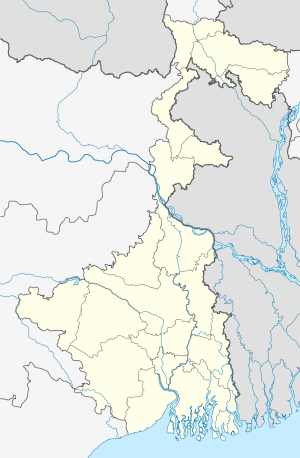Mayureswar II (community development block)
| Mayureswar II | |
|---|---|
| Community development block | |
 Mayureswar II Location in West Bengal | |
| Coordinates: 24°04′14″N 87°33′25″E / 24.07056°N 87.55694°E | |
| Country |
|
| State | West Bengal |
| District | Birbhum |
| Parliamentary constituency | Bolpur |
| Assembly constituency | Mayureswar |
| Area | |
| • Total | 61.14 sq mi (158.36 km2) |
| Population (2001) | |
| • Total | 113,050 |
| • Density | 1,850/sq mi (714/km2) |
| Time zone | IST (UTC+5.30) |
| PIN | 731218 |
| Area code(s) | +91 3462 |
| Literacy Rate | 62.77 per cent |
| Website | http://birbhum.nic.in/ |
Mayureswar II (community development block) (Bengali: ময়ূরেশ্বর II সমষ্টি উন্নয়ন ব্লক) is an administrative division in Rampurhat subdivision of Birbhum district in the Indian state of West Bengal. Mayureswar police station serves this block. Headquarters of this block is at Kotasur.[1][2]
Geography
Kotasur is located at 24°04′14″N 87°33′25″E / 24.070593°N 87.557025°E.
Mayureswar II community development block has an area of 158.36 km2.[2]
Gram panchayats
Gram panchayats of Mayureswar II block/panchayat samiti are: Daspalsa, Dhekha, Kaleswar, Kundala, Mayureswar, Shatpalsa and Ulkunda.[3]
Demographics
As per 2001 census, Mayureswar II block had a total population of 113,050, out of which 58,175 were males and 54,875 were females. Mayureswar II block registered a population growth of 14.40 per cent during the 1991-2001 decade. Decadal growth for Birbhum district was 17.88 per cent.[2] Decadal growth in West Bengal was 17.84 per cent.[4]
Scheduled castes at 35,297 formed around one-third the population. Scheduled tribes numbered 7,962.[5]
Literacy
As per 2001 census, Mayureswar II block had a total literacy of 62.77 per cent for the 6+ age group. While male literacy was 73.09 per cent female literacy was 51.84 per cent. Birbhum district had a total literacy of 61.48 per cent, male literacy being 70.89 per cent and female literacy being 51.55 per cent.[6]
Culture
Poush Sankranti fair is held at Shibpur in the Mayureswar police station. Gosaidas fair is held at Dakshingram. Dharma pujo fair is held at Ratma on the occasion of Buddha Purnima.[7]
The Sarbomongola Temple is located at Kundala. Its floor is made of white stone brought from Rajasthan.Nobody knows how old the temple is.This temple is the pride of this district.Once Sadhak Bamakhyapa of Tarapith came here and worshipped the Goddess here.
Rath Bari of Kundala is well known for its architectural beauty. A Rath Fair is held at Kundala on the eve of Rath Yatra. This fair is nearly 100 years old. Thousands of people from the surrounding villages throng to celebrate Rath Yatra at Kundala, one of the oldest villages in the district of Birbhum. Besides, at Kundala Borobari Durgapuja is 300 years old. The name and fame of this ancient village spread all over the district. Babu Janaki Nath Mukhopadhyay and his three sons namely Babu Ramaprasanna Mukhopadhyay, Rai Rajani Bhushan Mukhopadhyay bahadur, Babu Annada Prasanna Mukhopadhyay led a pivotal role in developing not only the surrounding area but also the entire district. This is perhaps the only village in the district where two separate primary schools for the boys and the girls were set up by the Zamindars.
References
- ↑ "Contact details of Block Development Officers". Birbhum district. West Bengal Government. Retrieved 2011-10-10.
- 1 2 3 "Provisional population totals, West Bengal, Table 4, Birbhum District (8)". Census of India 2001. Census Commission of India. Retrieved 2011-10-10.
- ↑ "Annexure A to the G.O. No.16 (Sanction)-RD/CCA/BRGF/1C-9/2008 dated 12.4.11". Government of West Bengal - Department of Panchayats & Rural Development. Retrieved 2011-10-10.
- ↑ "Provisional Population Totals, West Bengal. Table 4". Census of India 2001. Census Commission of India. Retrieved 2011-10-10.
- ↑ "TRU for all Districts (SC & ST and Total)". Census 2001. Census Commission of India. Retrieved 2011-10-10.
- ↑ "Provisional population totals, West Bengal, Table 5, Birbhum District". Census of India 2001. Census Commission of India. Retrieved 2011-10-10.
- ↑ Mukhopadhyay Aditya, Birbhumer Mela, Paschim Banga , Birbhum Special Issue, February 2006, (Bengali), pp. 203-214, Information & Cultural Department, Government of West Bengal.